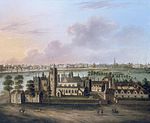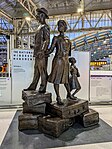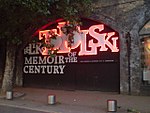The Royal National Theatre in London, commonly known as the National Theatre (NT), is one of the United Kingdom's three most prominent publicly funded performing arts venues, alongside the Royal Shakespeare Company and the Royal Opera House. Internationally, it is known as the National Theatre of Great Britain.Founded by Laurence Olivier in 1963, many well-known actors have performed at the National Theatre. Until 1976, the company was based at The Old Vic theatre in Waterloo. The current building is located next to the Thames in the South Bank area of central London. In addition to performances at the National Theatre building, the National Theatre tours productions at theatres across the United Kingdom. The theatre has transferred numerous productions to Broadway and toured some as far as China, Australia and New Zealand. However, touring productions to European cities was suspended in February 2021 over concerns about uncertainty over work permits, additional costs and delays because of Brexit. Permission to add the "Royal" prefix to the name of the theatre was given in 1988, but the full title is rarely used. The theatre presents a varied programme, including Shakespeare, other international classic drama, and new plays by contemporary playwrights. Each auditorium in the theatre can run up to three shows in repertoire, thus further widening the number of plays which can be put on during any one season.
In June 2009, the theatre began National Theatre Live (NT Live), a programme of simulcasts of live productions to cinemas, first in the United Kingdom and then internationally. The programme began with a production of Phèdre, starring Helen Mirren, which was screened live in 70 cinemas across the UK. NT Live productions have since been broadcast to over 2,500 venues in 60 countries around the world. In November 2020, National Theatre at Home was announced. It is a video on demand streaming service, specifically created for National Theatre Live recordings. Videos of plays are added every month, and can be "rented" for temporary viewing, or unlimited recordings can be watched through a monthly or yearly subscription programme.The NT had an annual turnover of approximately £105 million in 2015–16, of which earned income made up 75% (58% from ticket sales, 5% from NT Live and Digital, and 12% from commercial revenue such as in the restaurants, bars, bookshop, etc.). Support from Arts Council England provided 17% of income, 1% from Learning and Participation activity, and the remaining 9% came from a mixture of companies, individuals, trusts and foundations.












